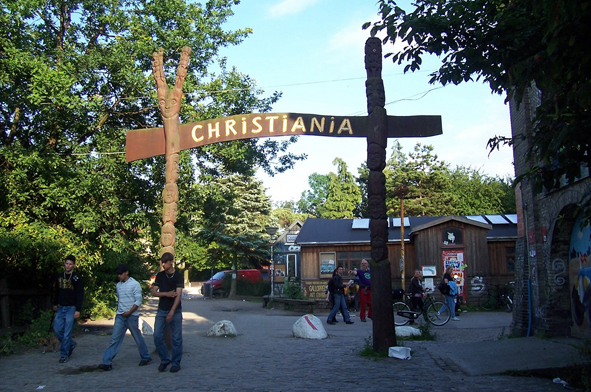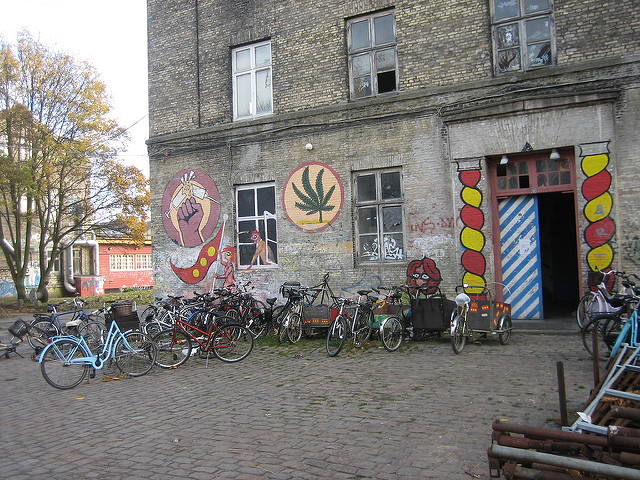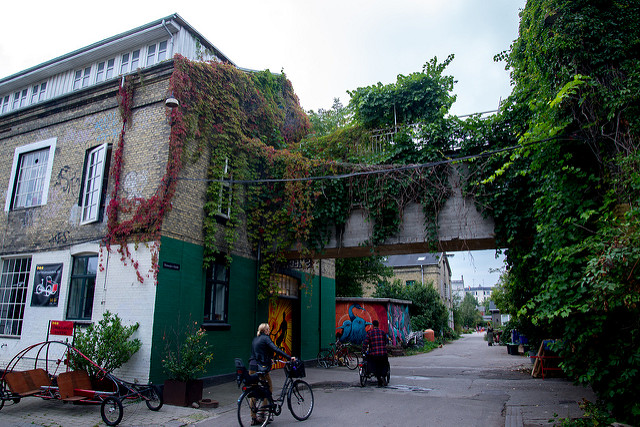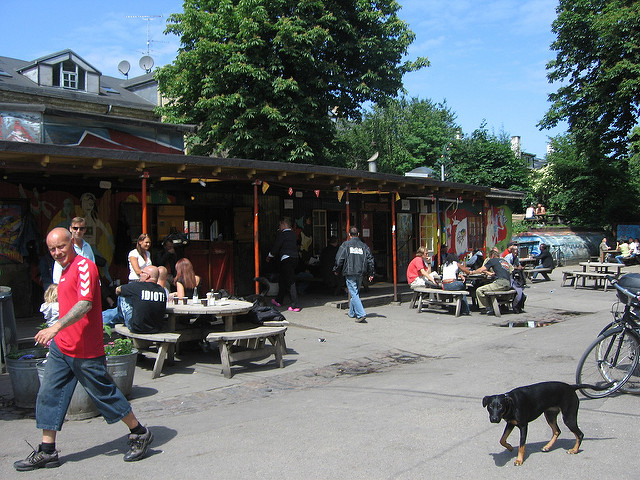Copenhagen’s famous Freetown, Christiania, began as a commune for 70s hippies looking to break free from the rules and regulations of Denmark. Over the years, it has evolved in to something entirely different.

The entrance to Christiania (Photo: kmaschke via Flickr)
I stood facing a sign that said, in no uncertain terms, that my camera was to stay firmly in my bag. It also advised me not to run, so that I didn’t panic anyone with my fast and sudden movements.
At this point, it’d be easy to think I was entering some kind of prison, or at least a highly regulated institution. In fact, I was about to step foot in something entirely different. Christiania is about as far from a prison as you can get, instead presenting itself as a “free” state hidden away in the confines of Copenhagen’s hustle and bustle.
The city’s famous hippie commune oozes the laidback lifestyle so prevalent in Copenhagen, but on a heightened scale. Here, the overgrown bushes and graffiti-clad huts are the antithesis of the well-structured, high-end architectural designs that flourish in the rest of the city. Each building seems to have been haphazardly put together with quirkiness the top priority – peeling wood characterized most dwellings, as did lopsided designs and a selection of uneven materials.
Stepping past the imposing sign at the entrance, I braced myself for the unknown. I’m not quite sure what I was expecting, but it certainly wasn’t the quiet, almost barren, village that greeted me.

A graffiti covered building in Christiania (Photo: Kieran Lynham via Flickr)
From Hippie Haven to No Man’s Land?
Meandering lanes passed derelict warehouses that were, at one point in history, an important set of military barracks. Windows were smashed in, and faded graffiti tags marred every available surface. Bikes with just one wheel lay scattered in the undergrowth. But the thing I noticed the most? The severe lack of people.
Granted, this was March and not the warmest month in Copenhagen, but there was barely any sign of life at all. A few eyes peered at me from behind dusty windows, and a couple of residents lounged in their doorways, passing wary eyes over passers-by, but that was it. I half expected to see a tangle of tumbleweed roll across the path in front of me.
This scene seems a far cry from what I imagine the early days were like back in 1971 when Christiania was founded. At the time, the hippy movement was in full swing, and a group of locals decided that setting up their own society, with its own rules and regulations, would be preferable to living amongst the entrenched laws of Denmark.
It is difficult to imagine that an individual commune could stand up against the centuries-old societal laws of Copenhagen, but Christiania was allowed to flourish. It wasn’t without angst and conflict, though. For the first forty years of its existence, its people found themselves in continuous clashes with the government, many of which centred around the Christianians dedication to legalizing drugs and their free, communist lifestyle.
However, I quickly learned the animosity that bubbled below the surface of Christiania had probably arisen in the last few years. In 2011, an agreement was made to ascertain the future of it. As part of it, the Foundation Freetown Christiania was set up and took over a large chunk of the insular society – the part that can be found outside the protected ramparts.

A street scene in Christiania (Photo: SnippyHolloW via Flickr)
Considering the town was originally founded to provide respite from the ownership of umbrella companies and to get away from the responsibilities and ties of usual societal life, it is easy to see why some of the residents have become jaded by its current situation.
An Underground World That Rose to the Surface
But as I wandered further into the hobbit-like world, past crumbling workshops, ramshackle workshops, and pretty cafes, I realized this wasn’t the only issue that had stalled Christiania in the present day. The main reason was, in fact, aligned with why I couldn’t get my camera out of my bag.
Drug dealers. And not the laidback, long-haired stereotype of the 70s kind of drug dealers. As Christiania rose in fame around the world, drug barrens from across Europe flocked to its tiny shores to push harder drugs than the marijuana of the founding fathers.
Now, Christiania is riddled with bald-headed, big-muscled drug lords touting stocky dogs and maybe a weapon or two concealed in their ripped jeans. Head along Pusher Street, the main stretch of Christiania, and you’ll see a few of them sitting around laughing, smoking, and eyeing up anyone who looks out of place.
This isn’t to say that Christiania is now a dangerous bubble in Copenhagen, but it’s definitely not the same nature-loving commune it began as, and I think this is what has seen it drastically change from a happy-go-lucky hotspot to somewhere with a darker narrative.

A busy cafe in summer in Christiania (Photo: Michael Bumann via Flickr)
Even so, I hear the summer months bring the community to life. When the cold winter air thaws, residents pile into makeshift squares and throw festivals featuring all sorts of music. Locals from outside Christiania swap their business suits for sandals and headbands when the sun comes out – a picture that I’m sure is reminiscent of the Freetown’s early days.
As I walk past graffiti-laden warehouses (at a much quicker pace that I would usually explore at), I tried to etch the colourful murals to memory, because I knew that once I stepped foot out of Christiania, it would feel like I never ventured there in the first place – and, of course, I’d have no photo evidence to prove I’d been.
I was shocked at the relief I felt when I turned a corner and saw the “Welcome Back to the EU” sign that marks the end of Christiania and the beginning of Copenhagen. For all its vibrant art and free living lifestyle, Christiania was burdened with a heavy air that no amount of 70s vibes could disperse. I could almost feel the lift in my chest as I stepped back onto the streets of Copenhagen – the Copenhagen governed by Danish laws and entrenched rules and regulations.
Looking back, the archway into Christiania forced a welcoming smile; the world beyond still trying to pick itself up from the hedonistic days of the 70s that had somehow, somewhere, hit a downward spiral into everything the founders of Christiania didn’t want it to be – at least, that’s how I saw it, as I turned my back on the Freetown and happily walked into the arms of familiarity.